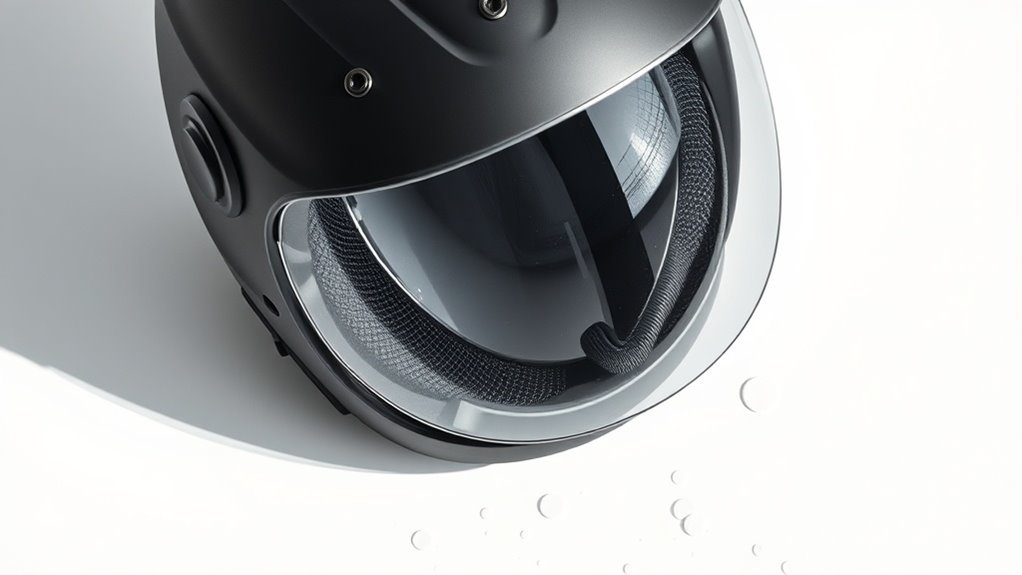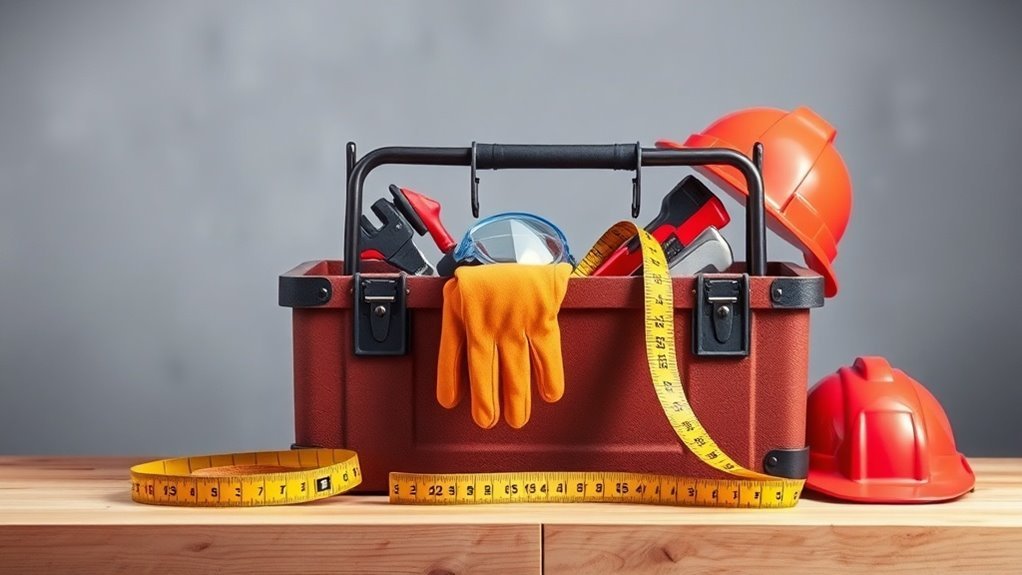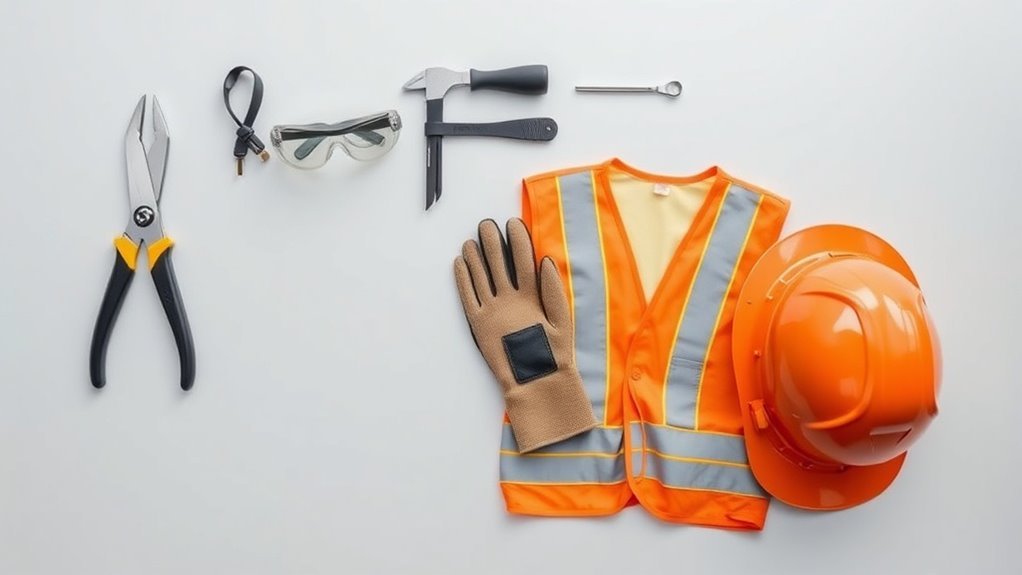Physics of Impact Resistance in Safety Helmets

The physics of impact resistance in safety helmets involves materials that absorb energy and distribute forces during impacts. Helmets feature an outer shell that deforms upon collision, while inner foam liners convert kinetic energy into heat, protecting your head from injuries. Correct fit plays a vital role too; if a helmet shifts or is too tight, its effectiveness is compromised. By exploring advances in helmet technology, you can uncover how innovations enhance safety and user experience even further.
Key Takeaways
- Helmets absorb impact energy through deformation, spreading and slowing down the force during a collision.
- Expanded polystyrene foam converts kinetic energy into heat, enhancing protection against severe impacts.
- Material selection, including polycarbonate and fiberglass, is crucial for effective energy absorption and helmet durability.
- The design of helmets influences how energy is distributed across the surface, enhancing overall safety.
- Continuous advancements in materials and technology improve helmet performance in absorbing and dissipating impact forces.
The Importance of Safety Helmets in High-Risk Environments
When you’re working in high-risk environments, the importance of safety helmets can’t be overstated.
These helmets act as a critical barrier between your head and potential hazards like falling objects or impacts from machinery. By wearing a helmet, you’re greatly reducing the risk of head injuries, which could lead to severe consequences.
It’s not just about compliance with regulations; it’s about ensuring your safety and well-being on the job. Remember, even minor accidents can lead to considerable injuries if you’re not protected.
Helmets are designed to absorb impact energy and distribute it evenly, enhancing your protection. The evolution of safety helmets has led to significant advancements in materials and designs that further improve safety features.
Materials Used in Safety Helmet Construction

When considering safety helmets, it’s essential to understand the materials used in their construction.
You’ll find that core materials, like polycarbonate and fiberglass, play a significant role in impact resistance.
Innovations in these materials are continually enhancing how helmets protect you in hazardous environments.
Core Materials Overview
While the design of safety helmets may vary, the core materials used in their construction play an essential role in ensuring ideal impact resistance and protection. Commonly, you’ll find a hard outer shell made from polycarbonate or fiberglass; these materials provide strength while remaining lightweight.
Beneath this shell, you’ll discover an inner foam liner, usually made from expanded polystyrene (EPS) or expanded polypropylene (EPP). These foams absorb energy during impacts, noticeably reducing the force transmitted to your head. Some helmets also feature additional cushioning layers for comfort and fit.
The combination of these materials is fundamental for enhancing both safety and usability, making sure you stay protected without compromising on comfort. Choosing the right helmet means understanding these foundational components.
Impact-Resistant Innovations
Advancements in technology are driving the development of impact-resistant materials for safety helmets, enhancing your protection on the job or during recreational activities. These innovative materials not only improve durability but also maximize comfort and performance.
Here are some cutting-edge innovations you should know:
- Carbon fiber composites: Super strong yet lightweight, these help in reducing impact forces efficiently.
- Expanded Polystyrene (EPS): This material absorbs and dissipates energy during an impact, providing essential cushioning.
- Vapor-permeable membranes: These keep you cool and dry, improving your focus and safety.
- Liquid crystal polymers: Offering a perfect blend of flexibility and strength, they adapt to varying impact conditions.
With these advancements, you can feel more secure as you take on new challenges.
The Science of Impact Absorption

Understanding the science of impact absorption is vital for the design and effectiveness of safety helmets. When you take a hit, the helmet’s outer layer typically deforms, which helps to slow down and spread out the force of the impact.
Materials like expanded polystyrene foam or specialized polymers are commonly used to absorb energy. These materials also convert kinetic energy into heat, reducing the risk of head trauma.
Knowing how different materials behave under varying forces is important for engineers. They need to guarantee that the helmet can withstand impacts without transferring too much energy to your skull.
Ultimately, this understanding leads to innovations that make helmets safer for everyday use in various activities and environments.
Energy Distribution and Helmet Design
When it comes to safety helmets, the choice of materials plays a vital role in how energy from an impact is absorbed.
You’ll find that the shape of the helmet also influences how that energy is distributed across the surface.
Understanding these factors can help you appreciate the design innovations aimed at enhancing impact resistance.
Material Selection Importance
Selecting the right materials for safety helmets is essential, since these choices directly affect how energy is distributed upon impact.
When you put on a helmet, you’re trusting that the materials can absorb and dissipate forces effectively, protecting you from serious injury.
The right materials not only enhance safety but also guarantee comfort and usability.
Here are four feelings that stem from appropriate material selection:
- Confidence – Knowing your helmet is constructed from high-quality materials.
- Safety – Feeling secure whether you’re riding a bike or on a construction site.
- Reliability – Trusting that your helmet will perform as designed in critical moments.
- Empowerment – Taking proactive steps to protect yourself and others.
Impact Absorption Mechanisms
Impact absorption mechanisms play an essential role in a helmet’s design, determining how effectively it protects against head injuries. Helmets often use materials like expanded polystyrene (EPS) that deform upon impact, dissipating energy through controlled compression. This not only reduces the force transmitted to your skull but also spreads the impact over a larger area, minimizing localized injuries.
The thickness and density of the padding contribute to how well the helmet withstands and absorbs impacts. Additionally, the presence of foam liners and air channels can enhance energy distribution, aiding in impact resistance.
Understanding these mechanisms helps you appreciate how well different helmet designs can safeguard against the risks of head trauma, ensuring you make informed choices in protective headgear.
Design Shape Influence
The design shape of a helmet profoundly influences how energy is distributed during an impact. A well-engineered helmet can mean the difference between safety and injury.
Understanding this can make you appreciate the importance of helmet design.
Consider these factors that affect energy distribution:
- Aero-dynamics: A streamlined shape helps reduce wind resistance, causing less strain on your neck during impacts.
- Curvature: Rounded designs can deflect forces more evenly across the helmet’s surface, minimizing localized pressure.
- Visor Integration: Properly designed visors can prevent whiplash by ensuring consistent energy transfer.
- Padding Arrangement: Strategic placement absorbs impact better, cradling your head with care.
Choosing the right helmet shape could protect not just your head, but your life.
Testing Standards for Impact Resistance
When it comes to ensuring safety, understanding testing standards for impact resistance in helmets is essential.
These standards, like those from the American National Standards Institute (ANSI) and the Snell Memorial Foundation, define how helmets should be tested to withstand impacts.
You’ll find that testing usually involves dropping a helmet onto a solid surface from a specific height, simulating real-world scenarios. Helmets must meet certain performance criteria, which include energy absorption and penetration resistance.
Additionally, it’s important to check for comfort and fit, as a helmet that isn’t secured properly can’t provide adequate protection.
Innovations in Safety Helmet Technology
As technology evolves, new innovations in safety helmet design are emerging to enhance protection and comfort. These advancements not only improve safety but also make wearing a helmet a more pleasant experience.
Here are some exciting developments:
- Smart Helmets: Integrated sensors monitor your essential signs and detect impacts, sending alerts in emergencies.
- Lightweight Materials: Advanced composites make helmets lighter without sacrificing strength, reducing fatigue during long use.
- Ventilation Systems: Enhanced airflow technology keeps you cool and comfortable even in tough conditions.
- Custom Fit Technology: Adjustable padding guarantees a snug fit, increasing safety while boosting comfort.
With these innovations, you’re not just wearing a helmet; you’re equipping yourself with the best in personal protection technology.
The Role of Proper Fit and Adjustment
While wearing a safety helmet may feel straightforward, achieving the right fit is essential for maximizing protection and comfort.
If your helmet’s too loose, it could shift during an impact, reducing its effectiveness. Conversely, a helmet that’s too tight can cause discomfort and distraction, making it less likely you’ll wear it properly.
To guarantee the right fit, adjust the chin straps and the internal padding; this way, the helmet sits snugly on your head without feeling restrictive.
Remember to check the fit regularly, especially if you change hairstyles or if the helmet gets worn. A well-fitted helmet enhances stability, assuring that it provides the impact resistance designed to protect your head in case of an accident.
Prioritize fit for best safety.
Future Trends in Safety Helmet Development
A well-fitted helmet is just the beginning of advancements in safety gear.
As technology evolves, you can expect exciting innovations that further improve your protection.
Imagine a future where:
Envision a world where safety gear integrates cutting-edge technology for unparalleled protection and comfort.
- Smart Helmets: Integrated sensors provide real-time impact data and alert emergency services when needed.
- Lightweight Materials: Advanced composites reduce weight, making helmets more comfortable without sacrificing strength.
- Customization: Tailored designs crafted from 3D scanning guarantee a perfect fit for every individual.
- Sustainable Production: Eco-friendly materials and processes help create helmets that respect both your safety and the environment.
These trends not only promise enhanced protection but also elevate your experience, helping you feel secure and confident in your pursuits.
Stay tuned; safety gear is about to transform!
Questions
How Do Temperature Changes Affect Helmet Performance?
Temperature changes can weaken the materials in helmets, impacting their performance. Extreme heat can cause softening, while cold can make them brittle. Always check manufacturer guidelines regarding temperature limits to guarantee your helmet remains effective.
What Is the Lifespan of a Safety Helmet?
Safety helmets usually last about five years, but that can feel like a lifetime! Always check for signs of wear, and remember, replacing them regularly guarantees you’re protecting yourself as best as possible.
Can Safety Helmets Be Reused After an Impact?
No, you shouldn’t reuse a safety helmet after an impact. Even if it looks fine externally, the internal structure might be compromised, reducing its ability to protect you during future incidents. Always replace it.
Are There Specific Helmets for Different Activities?
Just like a tailor fits a suit, helmets come in different varieties for various activities. Whether you’re cycling, climbing, or skating, it’s essential to choose the right helmet designed specifically for your chosen sport.
How Do Helmet Colors Influence Their Effectiveness?
Helmet colors don’t directly influence their effectiveness in protection, but brighter colors can improve visibility, helping others see you better. This can enhance safety in certain activities, reducing the risk of accidents or collisions.
Conclusion
To sum up, while some might argue that safety helmets can’t guarantee complete protection, their design and materials greatly enhance impact resistance, reducing the risk of severe injury. By understanding the physics behind these helmets and ensuring a proper fit, you’re not just wearing a piece of equipment; you’re actively safeguarding your well-being. As technology advances, these protective devices will continue to evolve, offering even greater levels of safety in high-risk environments. Your safety truly hinges on informed choices and advancements.






